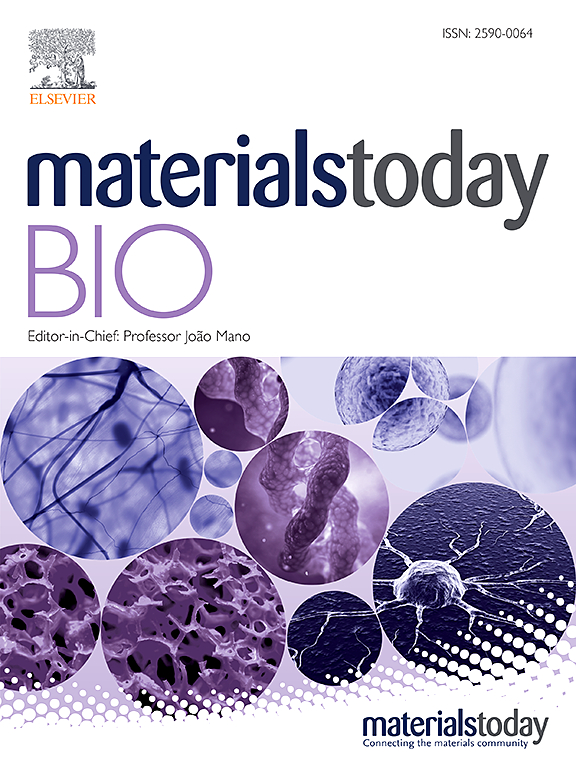A novel strategy for bone defect repair: Stromal cell-derived factor 1α sustained-release acellular fish scale scaffolds combined with injection of bone marrow mesenchymal stem cells promote bone regeneration
IF 8.7
1区 医学
Q1 ENGINEERING, BIOMEDICAL
引用次数: 0
Abstract
Patients with bone defects often have weak cell vitality and differentiation ability of endogenous bone marrow mesenchymal stem cells (BMSCs), which makes bone regeneration face challenges. At present, the bone tissue engineering strategies are mainly to build grafts by loading cells on scaffolds in vitro. These strategies face many difficulties that limit their clinical application. To this end, we developed a new strategy for bone defect repair, namely chemotactic cell-free scaffolds combined with BMSCs injection. We first prepared a polydopamine-functionalized acellular fish scale scaffold that can continuously release stromal cell-derived factor 1α (SDF-1α) (termed as SDF-1α/PAFS) in vivo for at least 10 days. The study results showed that the scaffold not only has excellent mechanical properties and good biocompatibility but also has reactive oxygen scavenging activity, immunomodulation, angiogenesis, and osteogenesis. More importantly, SDF-1α/PAFS can recruit postoperatively injected BMSCs into bone defects for bone repair. We constructed the mouse cranial bone defect model, and in vivo experimental results confirmed that the strategy of combining SDF-1α/PAFS with BMSCs injection can effectively promote bone defect repair. Overall, this study provides a promising strategy for bone defect repair, with better clinical convenience and operability.

骨缺损修复新策略:基质细胞衍生因子1α缓释脱细胞鱼鳞支架联合骨髓间充质干细胞促进骨再生
骨缺损患者往往内源性骨髓间充质干细胞(BMSCs)细胞活力和分化能力较弱,使骨再生面临挑战。目前,骨组织工程的策略主要是在体外将细胞加载到支架上构建移植物。这些策略面临许多困难,限制了它们的临床应用。为此,我们开发了一种新的骨缺损修复策略,即无趋化细胞支架联合骨髓间充质干细胞注射。我们首先制备了一种多多巴胺功能化的脱细胞鱼鳞支架,该支架可以在体内连续释放基质细胞衍生因子1α (SDF-1α)(称为SDF-1α/PAFS)至少10天。研究结果表明,该支架不仅具有优异的力学性能和良好的生物相容性,而且具有活性氧清除、免疫调节、血管生成和成骨等功能。更重要的是,SDF-1α/PAFS可以募集术后注入的骨髓间充质干细胞到骨缺损中进行骨修复。我们构建了小鼠颅骨骨缺损模型,体内实验结果证实了SDF-1α/PAFS联合BMSCs注射策略能有效促进骨缺损修复。总之,本研究为骨缺损修复提供了一个有前景的策略,具有较好的临床便利性和可操作性。
本文章由计算机程序翻译,如有差异,请以英文原文为准。
求助全文
约1分钟内获得全文
求助全文
来源期刊

Materials Today Bio
Multiple-
CiteScore
8.30
自引率
4.90%
发文量
303
审稿时长
30 days
期刊介绍:
Materials Today Bio is a multidisciplinary journal that specializes in the intersection between biology and materials science, chemistry, physics, engineering, and medicine. It covers various aspects such as the design and assembly of new structures, their interaction with biological systems, functionalization, bioimaging, therapies, and diagnostics in healthcare. The journal aims to showcase the most significant advancements and discoveries in this field. As part of the Materials Today family, Materials Today Bio provides rigorous peer review, quick decision-making, and high visibility for authors. It is indexed in Scopus, PubMed Central, Emerging Sources, Citation Index (ESCI), and Directory of Open Access Journals (DOAJ).
 求助内容:
求助内容: 应助结果提醒方式:
应助结果提醒方式:


